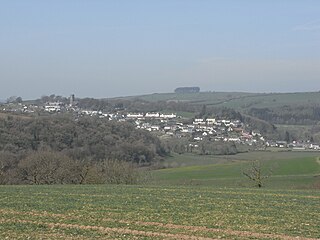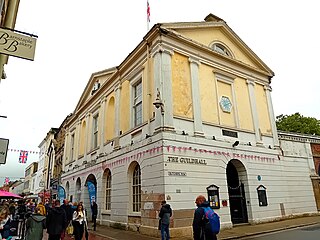
Totnes is a market town and civil parish at the head of the estuary of the River Dart in Devon, England, within the South Devon Area of Outstanding Natural Beauty. It is about 5 miles (8.0 km) west of Paignton, about 7 miles (11 km) west-southwest of Torquay and about 20 miles (32 km) east-northeast of Plymouth. It is the administrative centre of the South Hams District Council.

Barnstaple is a river-port town and civil parish in the North Devon district of Devon, England. The town lies at the River Taw's lowest crossing point before the Bristol Channel. From the 14th century, it was licensed to export wool from which it earned great wealth. Later it imported Irish wool, but its harbour silted up and other trades developed such as shipbuilding, foundries and sawmills. A Victorian market building survives, with a high glass and timber roof on iron columns.

Tavistock is an ancient stannary and market town within West Devon, England. It is situated on the River Tavy from which its name derives. At the 2011 census the three electoral wards had a population of 13,028. It traces its recorded history back to at least 961 when Tavistock Abbey, whose ruins lie in the centre of the town, was founded. Its most famous son is Sir Francis Drake.

North Devon is a local government district in Devon, England. Its council is based just outside Barnstaple, the district's largest town. The district also includes the towns of Ilfracombe, Lynton and Lynmouth and South Molton along with numerous villages and surrounding rural areas.

Plympton is a suburb of the city of Plymouth in Devon, England. It is in origin an ancient stannary town. It was an important trading centre for locally mined tin, and a seaport before the River Plym silted up and trade moved down river to Plymouth and was the seat of Plympton Priory the most significant local landholder for many centuries.
South Molton is a town and civil parish in Devon, England. It is part of the North Devon local government district. The town is on the River Mole.

Bishop's Nympton is a village and civil parish in the North Devon district of Devon, England, about three miles east of South Molton. According to the 2001 census it had a population of 932. The electoral ward has the same name but covers the village and much of the land to the north-east. The ward population at the 2011 census was 1,911.

Chulmleigh is a small Saxon hilltop market town and civil parish located in North Devon in the heart of the English county of Devon. It is located 20 miles (32 km) north west of Exeter, just north of the Mid Devon boundary, linked by the A377 and B3096 roads.

Swimbridge is a village, parish and former manor in Devon, England. It is situated 4 miles (6.4 km) south-east of Barnstaple and twinned with the town of St.Honorine Du Fay in Normandy, France. It was the home of the Rev. John "Jack" Russell who first bred the Jack Russell Terrier.

North Molton is a village, parish and former manor in North Devon, England. The population of the parish in 2001 was 1,047, decreasing to 721 in the 2011 census. An electoral ward with the same name also exists. The ward population at the census was 2,206. Bounded on the north east by the border with Somerset, it is the second largest parish in Devon, covering about 15,000 acres. Until the 18th century the village was an important centre of the woollen industry, and mining was also a significant employer in the parish until the 19th century.

Stowe House in the parish of Kilkhampton in Cornwall, England, UK, was a mansion built in 1679 by John Grenville, 1st Earl of Bath (1628–1701) and demolished in 1739. The Grenville family were for many centuries lords of the manor of Kilkhampton, which they held from the feudal barony of Gloucester, as they did their other principal seat of nearby Bideford in Devon. It is possible that the family's original residence at Kilkhampton was Kilkhampton Castle, of which only the groundworks survive, unusual in that it had a motte with two baileys.

Hugh Squier (1625-1710) of Petty France, Westminster, was a wealthy merchant best remembered as a generous benefactor to the town of South Molton in Devon, the place of his birth, where in 1684 he founded a "free school".

The Mayor of South Molton in Devon is an ancient historical office which survives at the present time. In the Middle Ages the town of South Molton was incorporated by royal charter into a borough governed by a mayor and Corporation. This enabled the inhabitants to free themselves from the jurisdiction of the lord of the manor of South Molton and to subject themselves instead to the jurisdiction of the king.

George Nympton or Nymet St George is a small village and civil parish in North Devon district, Devon, England. In the 2011 census it was recorded as having a population of 175.

A pannier market is a form of indoor market especially popular in Devon in the West Country of the United Kingdom where they can be found in various cities and towns. They take their name from the panniers once used to carry goods to market on the back of pack animals.

The Guildhall in Barnstaple in Devon in the United Kingdom is the Guildhall for the town and was completed in 1828, replacing an earlier Guildhall. Beneath and behind the Guildhall is the Pannier Market; completed in 1855, the building has been a Grade II* listed building since 19 January 1951.

The Pannier Market in Bideford in North Devon is a large covered Victorian pannier market together with the Butcher's Row of small artisan stalls running along the lower level of the Market. There has been a market on the site since 1675. Since 1989 it has been a Grade II listed building on the register of Historic England.

The Pannier Market in Great Torrington in Devon is a Victorian pannier market of 12 small indoor shops - six either side of a narrow cobbled lane built in 1842 and restored in 1999. The Market House building at the front of the complex has been a Grade II* listed building on the Historic England Register since 1951.

The Guildhall on Broad Street in South Molton in Devon was built between 1739 and 1743 and has been a Grade I listed building on the Register of Historic England since 1951. Today the building is the town hall for South Molton. Beside it, beneath the Old Assembly Room, is the entrance to the Pannier Market for the town.



















